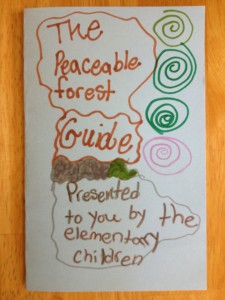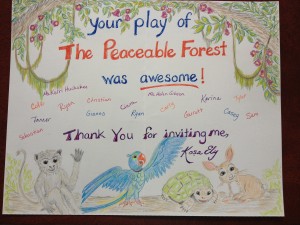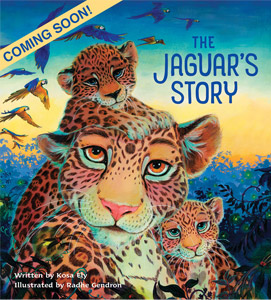“Can you come? It would mean so much to the children,” Helen asked. “They wanted me to call and invite you when they found out you live in Gainesville.”
Helen teaches art at Flagler Beach Montessori school, about a two hour drive from Gainesville. I met Helen last year when she purchased a Peaceable Forest book to share with her students. Now these students are putting on a play based on the book.
It’s their end-of-the-year play, so their families will be there too.
Helen said, “Of all the books they read this year they chose your book for their play. They’ve made their own animal masks and costumes too.”
I would love to get to see their reenactment of this ancient tale! As far as I know, these are the first children to do a play from my book. When the day comes I am greeted by Kerri, the school owner and teacher for the upper grades. Hanging from the ceiling are monkeys, birds and an assortment of other animals. Looks like a perfect forest setting for the play.
Soon parents, grandparents, and siblings arrive. After more than a hundred relatives are settled in their chairs, the program begins.
The pre-school children parade into the center of the room, each wearing a hand-painted ocean blue t-shirt with sea creatures and fish. They sing and act out a song about our oceans. After our enthusiastic applause they sit to watch the play.
Everyone in the audience receives a handmade program for the upcoming play. Inside is a typed list of the characters and the names of the actors.
Fifteen children, ages seven to eleven, come in the center of the room with their masks and costumes. The buck’s mask has large antlers and a protruding nose. The two bunny rabbits have white cotton ball tails and masks with whiskers and floppy ears. Each handmade mask is unique: coyotes, deer, birds, tiger, and boar. The tortoises wear large painted shells on their backs.
Sage Narada is, for this play, a holy woman, wearing colorful, draped cloth. The boy playing the hunter has his bow and arrows ready at his side. They both have learned many lines and do a great job with their delivery.
Kerri narrates, and the book serves as the script. The audience hears the entire story of Mrigari the hunter and Sage Narada.
At the end of the play Kerri gives the audience and myself the back story, “Last year when the children read this book, they decided this would be their play for the following year. They waited an entire year to put on this play for you. The book’s message: to walk lightly on the earth, and to show respect and empathy for all living beings, is so important. We teach this in many ways at our school; how each of our actions impacts others, and the world around us.”
Kerri reads a quote from Black Elk (below) and offers her appreciation to her fellow teachers, parents and students.
Now comes my favorite part. I get to meet each child, thank them, and write a personal message in their book.
A big thank you to Helen, Kerri, all the children and their parents.
“Everything the Power of the World does is done in a circle. The sky is round, and I have heard that the earth is round like a ball, and so are all the stars. The wind, in its greatest power whirls. Birds make their nest in circles, for theirs is the same religion as ours. The sun comes forth and goes down again in a circle. The moon does the same and both are round. Even the seasons form a great circle in their changing, and always come back again to where they were. The life of a man is a circle from childhood to childhood, and so it is in everything where power moves. Our tepees were round like the nests of birds, and these were always set in a circle, the nation’s hoop.” —Black Elk




Recent Comments